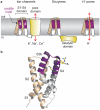Sensing voltage across lipid membranes
- PMID: 19092925
- PMCID: PMC2629456
- DOI: 10.1038/nature07620
Sensing voltage across lipid membranes
Abstract
The detection of electrical potentials across lipid bilayers by specialized membrane proteins is required for many fundamental cellular processes such as the generation and propagation of nerve impulses. These membrane proteins possess modular voltage-sensing domains, a notable example being the S1-S4 domains of voltage-activated ion channels. Ground-breaking structural studies on these domains explain how voltage sensors are designed and reveal important interactions with the surrounding lipid membrane. Although further structures are needed to understand the conformational changes that occur during voltage sensing, the available data help to frame several key concepts that are fundamental to the mechanism of voltage sensing.
Figures





References
-
- Noda M, et al. Expression of functional sodium channels from cloned cDNA. Nature. 1986;322:826–8. - PubMed
-
- Tanabe T, et al. Primary structure of the receptor for calcium channel blockers from skeletal muscle. Nature. 1987;328:313–8. - PubMed
-
- Tempel BL, Papazian DM, Schwarz TL, Jan YN, Jan LY. Sequence of a probable potassium channel component encoded at Shaker locus of Drosophila. Science. 1987;237:770–5. - PubMed
-
- Jiang Y, et al. X-ray structure of a voltage-dependent K+ channel. Nature. 2003;423:33–41. - PubMed
Publication types
MeSH terms
Substances
Grants and funding
LinkOut - more resources
Full Text Sources
Other Literature Sources
Molecular Biology Databases

